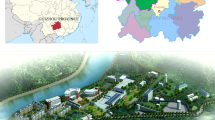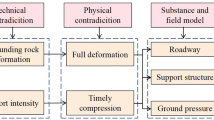Abstract
Based on the geological conditions of soft-rock roadway with a buried depth of 1336 m and the data that are achieved by various experimental methods, the multi-factor coupling analysis of the instability mechanism of soft-rock roadway is carried out through theoretical analysis and numerical simulation. Additionally, following the Nishihara model and Drucker–Prague’s modification of Mohr–Coulomb yield condition, the stability control theory of soft-rock coal roadway is analyzed. By fully considering the bearing capacity of each supporting component, the original supporting structure is innovatively examined with crush tube, spherical tray, high-strength bar and steel strip to form a flexible and high-performance bolt supporting structure, and the stability control of 1336 m soft-rock coal roadway is also comprehended. Therefore, the studies have shown that the convergence trend of omnidirectional, strong rheological and large deformation constitutes the essential characteristics of deep soft-rock roadway deformation. The instability process of roadway surrounding rock is accompanied by “domino-effect” similar to that of multi-factor coupling. The irrational design of the support scheme and the destruction of the support structure are the external factors of this effect, although the prominent contradiction between high in-situ stress and the weak bearing capacity of the deep degraded rock mass is the internal factors of this effect. Similarly, the engineering practice and observation data of the new scheme have shown that the deformation coordination of support components and the matching degree of bearing characteristics should be one of the main factors to be considered in the design of deep soft-rock roadway support, high elongation and multiple adjustable characteristics to adapt to the basic characteristics of deep soft-rock roadway deformation. Hence, the construction idea of the new scheme has contributed the satisfactory engineering significances and reference value for optimizing the stress environment of soft-rock roadway and further reducing the support cost.















Similar content being viewed by others
Abbreviations
- NATM:
-
New Austrian tunneling method
- ASTM:
-
American society for testing and materials
- ISRM:
-
International society for rock mechanics
- CCNSCB:
-
Cracked chevron-notched semi-circular bend
- CCNBD:
-
Cracked chevron-notched Brazilian disc
- H :
-
Height of roadway
- n :
-
Assurance factor
- a :
-
Radius of roadway
- p α :
-
Supporting intensity
- G 1 :
-
Shear modulus
- r :
-
Depth of surrounding rock
- S :
-
Anchor row space
- p :
-
The axial force of anchor bolt
- k :
-
Stiffness of anchor bolt
- \( \Delta u^{r} \) :
-
Radial displacement of rock stratum
- E :
-
Elasticity modulus
- M φ :
-
Friction angle-softening modulus
- F :
-
The normal yield of material under three-dimensional stress
- 〈F〉:
-
The normal yield of material under three-dimensional stress conditions
- L :
-
Roadway width
- [r]:
-
The radius of loose surrounding rock
- p 0 :
-
In-situ stress
- G 1 :
-
Shear modulus
- b :
-
Bolt spacing
- d :
-
Thickness of the compression band
- p r :
-
Pre-strength of anchor bolt
- u :
-
Surrounding rock displacement
- v :
-
Surrounding rock migration rate
- A :
-
Cross-sectional area
- M c :
-
Viscosity-softening modulus
- L 0 :
-
Supporting length
- \( \sigma_{\rho } \) :
-
The radial stress
- \( \sigma_{\theta } \) :
-
Circumferential stress
- \( \sigma_{H\text{max} } \) :
-
Maximum horizontal principal stress
- \( \sigma_{H\text{min} } \) :
-
Minimum horizontal principal stress
- \( \sigma_{1} \) :
-
Maximum principal stress
- \( \sigma_{3} \) :
-
Minimum principal stress
- \( \sigma_{t} \) :
-
Tensile strength
- \( \sigma_{n} \) :
-
Normal stress
- \( \sigma_{c} \) :
-
Vertical principal stress
- \( \sigma_{c}^{{\prime }} \) :
-
Residual cohesion
- \( \sigma_{r}^{e} \) :
-
Effective radial stress of the elastic–plastic boundary surface
- \( \tau_{\rho \theta } \) :
-
Shear stress
- \( \varphi \) :
-
Internal friction
- \( \varphi^{{\prime }} \) :
-
The residual angle of internal friction
- \( \eta_{1} \) :
-
Proportional constant
- \( \psi_{1} \) :
-
Viscosity coefficient
- \( \psi_{2} \) :
-
Viscosity coefficient
- \( \mu \) :
-
Poisson’s ratio
- [\( \varepsilon \)]:
-
The critical strain of rock mass
- \( \varepsilon \) :
-
Linear strain
- \( \varepsilon_{e} \) :
-
Elastic linear strain
References
Aliha MRM, Bahmani A (2017) Rock fracture toughness study under mixed mode I/III loading. Rock Mech Rock Eng 50(7):1739–1751. https://doi.org/10.1007/s00603-017-1201-7
Aliha MRM, Sistaninia M, Smith DJ, Ayatollahi MR (2012) Geometry effects and statistical analysis of mode I fracture in guiting limestone. Int J Rock Mech Min Sci 51:128–135. https://doi.org/10.1016/j.ijrmms.2012.01.017
Ayatollahi MR, Aliha MRM (2004) Fracture parameters for a cracked semi-circular specimen. Int J Rock Mech Min Sci 41(3):356. https://doi.org/10.1016/j.ijrmms.2003.12.061
Ayatollahi M, Varasteh S (2017) Anti-plane interface cracks between two dissimilar orthotropic layers. J Phys: Conf Ser 843(1):12–13. https://doi.org/10.1088/1742-6596/843/1/012013
Ayatollahi MR, Karami J, Saboori B (2019) Mixed mode II/III fracture experiments on PMMA using a new test configuration. Eur J Mech/A Solids 77:1–9. https://doi.org/10.1016/j.euromechsol.2019.103812
Colussi M, Berto F, Mori K, Narita F (2016) Effect of the loading rate on the brittle fracture of terfenol-d specimens in magnetic field: strain energy density approach. Strength Mater 48(6):791–800. https://doi.org/10.1007/s11223-017-9826-z
Erarslan N (2013) A study on the evaluation of the fracture process zone in ccnbd rock samples. Exp Mech 53(8):1475–1489. https://doi.org/10.1007/s11340-013-9750-5
Erarslan N, Williams DJ (2012) Investigating the effect of cyclic loading on the indirect tensile strength of rocks. Rock Mech Rock Eng 45(3):327–340. https://doi.org/10.1007/s00603-011-0209-7
Erarslan N, Alehossein H, Williams DJ (2014) Tensile fracture strength of brisbane tuff by static and cyclic loading tests. Rock Mech Rock Eng 47(4):1135–1151. https://doi.org/10.1007/s00603-013-0469-5
Feng X, Nong Z, He F, Yang S, Zheng X (2017) Implementation of a pre-tensioned, fully bonded, bolting system and its failure mechanism based on acoustic emission: a laboratorial and field study. Geotech Test J 40(6):978–999. https://doi.org/10.1520/GTJ20160157
Feng P, Dai F, Liu Y, Nuwen X, Zhao T (2018) Effects of strain rate on the mechanical and fracturing behaviors of rock-like specimens containing two unparallel fissures under uniaxial compression. Soil Dyn Earthq Eng 110:195–211. https://doi.org/10.1016/j.soildyn.2018.03.026
Frith R, Reed G, McKinnon M (2018) Fundamental principles of an effective reinforcing roof bolting strategy in horizontally layered roof strata and areas of potential improvement. Int J Mining Sci Technol 28(1):67–77. https://doi.org/10.1016/j.ijmst.2017.11.011
Ghamgosar M, Erarslan N (2016) Experimental and numerical studies on development of fracture process zone (FPZ) in rocks under cyclic and static loadings. Rock Mech Rock Eng 49(3):893–908. https://doi.org/10.1007/s00603-015-0793-z
Ghamgosar M, Erarslan N, Williams DJ (2017) Experimental investigation of fracture process zone in rocks damaged under cyclic loadings. Exp Mech 57(1):97–113. https://doi.org/10.1007/s11340-016-0216-4
Ghazvinian A, Nejati HR, Sarfarazi V, Hadei MR (2013) Mixed mode crack propagation in low brittle rock-like materials. Arab J Geosci 6(11):4435–4444. https://doi.org/10.1007/s12517-012-0681-8
Huang W, Wang X, Shen Y, Feng F, Wu K, Li C (2018a) Application of concrete—filled steel tubular columns in gob-side entry retaining under thick and hard roof stratum: a case study. Energy Sci Eng 018(00):1–14. https://doi.org/10.1002/ese3.442
Huang W, Yuan Q, Tan Y, Wang J, Liu G, Guang-long Q, Li C (2018b) An innovative support technology employing a concrete-filled steel tubular structure for a 1000-m-deep roadway in a high in situ stress field. Tunn Undergr Space Technol 73:26–36. https://doi.org/10.1016/j.tust
Kang H (2014) Support technologies for deep and complex roadways in underground coal mines: a review. Int J Coal Sci Technol 1(3):261–277. https://doi.org/10.1007/s40789-014-0043-0
Kang H, Wu Y, Gao F (2011) Deformation characteristics and reinforcement technology for entry subjected to mining-induced stresses. J Rock Mech Geotech Eng 3(3):207–219. https://doi.org/10.3724/SP.J.1235.2011.00207
Kang H, Yang J, Meng X (2015) Tests and analysis of mechanical behaviours of rock bolt components for China’s coal mine roadways. J Rock Mech Geotech Eng 7:14–26. https://doi.org/10.1016/j.jrmge.2014.12.002
Liu Q, Yang K, Hua X, Li B (2016) In-situ stress measurement and its engineering application in deep coal mines: a case study in the Xinji Coalfield of China. J Eng Sci Technol Rev 9(6):59–68
Liu Y, Dai F, Nuwen X, Zhao T, Feng P (2018) Experimental and numerical investigation on the tensile fatigue properties of rocks using the cyclic flattened Brazilian disc method. Soil Dyn Earthq Eng 105:68–82. https://doi.org/10.1016/j.soildyn.2017.11.025
Lu Y, Wang L, Zhang B (2011) An experimental study of a yielding support for roadways constructed in deep broken soft rock under high stress. Mining Sci Technol 21(6):839–844. https://doi.org/10.1016/j.mstc.2011.05.034
Nazerigivi A, Nejati HR, Ghazvinian A, Najigivi A (2018) Effects of SiO2 nanoparticles dispersion on concrete fracture toughness. Constr Build Mater 171:672–679. https://doi.org/10.1016/j.conbuildmat.2018.03.224
Serati M, Alehossein H, Erarslan N (2016) The brazilian disc test under a non-uniform contact pressure along its thickness. Rock Mech Rock Eng 49(4):1573–1577. https://doi.org/10.1007/s00603-015-0773-3
Shreedharan S, Kulatilake PHSW (2016) Discontinuum-equivalent continuum analysis of the stability of tunnels in a deep coal mine using the distinct element method. Rock Mech Rock Eng 49(5):1903–1922. https://doi.org/10.1007/s00603-015-0885-9
Song W, Liu X, Berto F (2018) Multiaxial fatigue crack orientation and early growth investigation considering the nonproportional loading. Phys Mesomech 21(4):358–370. https://doi.org/10.1134/S1029959918040100
Sun L (2015) Support failure of a high-stress soft-rock roadway in deep coal mine and the equalized yielding support technology: a case study. Int j Coal Sci Technol 2(4):279–286. https://doi.org/10.1007/s40789-015-0093-y
Tan Y, Yu F, Ning J, Zhao T (2015) Design and construction of entry retaining wall along a gob side under hard roof stratum. Int J Rock Mech Min Sci 77:115–121. https://doi.org/10.1016/j.ijrmms.2015.03.025
Wang H, Zheng P, Zhao W, Tian H (2018) Application of a combined supporting technology with U-shaped steel support and anchor-grouting to surrounding soft rock reinforcement in roadway. J Central South Univ 25(5):1240–1250. https://doi.org/10.1007/s11771-018-3821-9
Xu Y, Dai F (2017) Dynamic response and failure mechanism of brittle rocks under combined compression-shear loading experiments. Rock Mech Rock Eng 51(3):747–764. https://doi.org/10.1007/s00603-017-1364-2
Yang Y, Li H (2012) Failure mechanism of large-diameter shield tunnels and its effects on ground surface settlements. J Central South Univ 19:2958–2965. https://doi.org/10.1007/s11771-012-1364-z
Yu W, Wang W, Chen X, Du S (2015) Field investigations of high stress soft surrounding rocks and deformation control. J Rock Mech Geotech Eng 4:421–433. https://doi.org/10.1016/j.jrmge.2015.03.014
Yu W, Wu G, An B (2016) Investigations of support failure and combined support for soft and fractured coal-rock tunnel in tectonic belt. Geotech Geol Eng 36(6):3911–3929. https://doi.org/10.1007/s10706-018-0582-z
Zhang G, He F, Lai Y, Jia H (2018) Ground stability of underground gateroad with 1 km burial depth: a case study from Xingdong coal mine, China. J Central South Univ 25(6):1386–1398. https://doi.org/10.1007/s11771-018-3834-4
Zhao J, Zhang Y (2017) Studies on rock failure of layered rock in underground mining-face and control techniques. Geomech Geophys Geo-Energy Geo-Resour 3(4):405–414. https://doi.org/10.1007/s40948-017-0068-0
Zheng X, Zhang L, Zhang N (2013) Pre-stressed anchorage function and evolution in the roof of rectangular roadway in deep mine. J China Univ Mining Technol 42(6):929–934. https://doi.org/10.13247/j.cnki.jcumt.2013.06.007
Zhu X, Ren Y (2019) Numerical Simulation Study on the Anchorage Mechanism of Yield Supporting in Deep Tunnel. Geotech Geol Eng 37(3):2091–2102. https://doi.org/10.1007/s1070
Acknowledgements
The research was funded by the National Natural Science Foundation of China (No.51574226), 2017 special project of Subject Frontiers Scientific Research in China University of Mining and Technology (2017XKQY047), and the National Natural Science Foundation of Guangdong (No. 2018A0303130162). The authors would like to thank Suncun Coal Mine for providing field geological and geotechnical data about this research, and for providing the encouragement to conduct this research and to publish the research findings.
Author information
Authors and Affiliations
Corresponding author
Ethics declarations
Conflict of interest
The author declares no conflict of interest.
Additional information
Publisher's Note
Springer Nature remains neutral with regard to jurisdictional claims in published maps and institutional affiliations.
Rights and permissions
About this article
Cite this article
Zhan, Q., Zheng, X., Du, J. et al. Coupling Instability Mechanism and Joint Control Technology of Soft-Rock Roadway with a Buried Depth of 1336 m . Rock Mech Rock Eng 53, 2233–2248 (2020). https://doi.org/10.1007/s00603-019-02027-9
Received:
Accepted:
Published:
Issue Date:
DOI: https://doi.org/10.1007/s00603-019-02027-9




